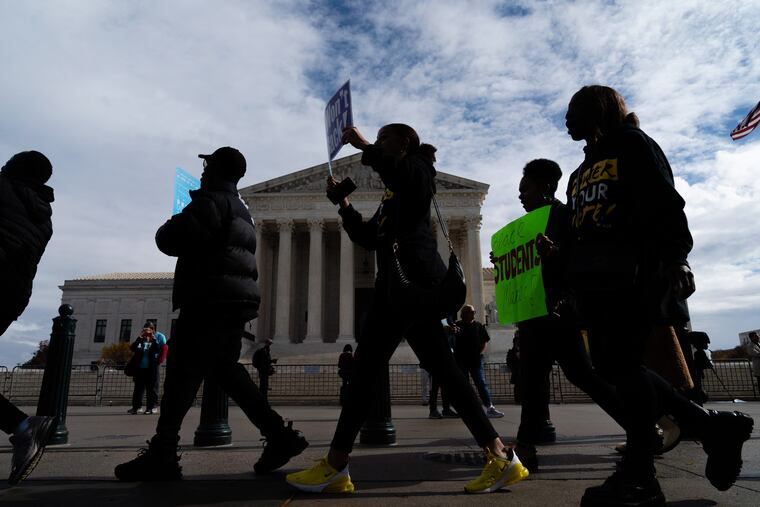Affirmative action is gone. Here’s how to keep fighting.
It's up to public schools to step up, and all of us to keep fighting to protect race-conscious practices outside of college admissions.

On Thursday, the U.S. Supreme Court upended decades of precedent when it declared unlawful the practice of colleges and universities considering race in the admissions process. The practice, which is commonly known as affirmative action and was upheld by the court as recently as 2003, allowed institutions of higher education to consider race as one of many factors when evaluating students’ applications.
The court’s decisions in Students for Fair Admissions Inc. v. President and Fellows of Harvard College and Students for Fair Admissions Inc. v. University of North Carolina, however, now prevent both public institutions and private institutions receiving public funds from directly considering race as a factor, including in a limited manner.
By eliminating race-conscious admissions, this court has pulled the rug out from beneath students of color nationwide who aspire to get ahead in our society. But although the court has severely disadvantaged those students, all hope is not lost. There are still actions government leaders and colleges and universities can take to ensure students of color are not entirely shut out from the American dream for generations to come.
» READ MORE: Supreme Court could drop ‘wrecking ball’ on another legal precedent | Opinion
The original purpose of affirmative action was to level the playing field for students of color — who remain at a significant disadvantage when it comes to college admissions, despite all the progress that’s been made.
Don’t believe us? Just consider Philadelphia, where most of the students in our public schools are Black, and where schools are underfunded relative to other school systems in the state by more than $1.1 billion — or more than $5,500 per student. The typical student from nearly any other Pennsylvania district — who is most likely white — has therefore likely received a better high school education than a student in Philadelphia, and may therefore have an advantage when applying to college.
If colleges and universities are less able to help ease that disparity, then it’s up to our public schools to step up.
First, state and local leaders must do everything in their ability to rebuild and invest in public education, to help provide students of color with an equal opportunity at college admissions. In Pennsylvania, this means the General Assembly must provide public school districts with equitable resources to adequately address their students’ needs, and close the funding gap that separates higher-income districts from lower-income ones. The General Assembly can do so by allocating funds that are proportional to the needs of each school district, which would put Pennsylvania’s funding system in compliance with a recently decided Commonwealth Court decision that requires the state to provide every student “access to a comprehensive, effective, and contemporary system of public education.”
An equitable funding system will address the needs of Black and Hispanic students and subsequently give them the best shot at college admissions.
It’s hard to see this as anything but a cultural backlash.
Second, colleges and universities must find other ways to level the playing field for students of color by shifting their recruiting, admissions, and financial aid practices. That includes demystifying the admissions process, which requires engaging in early, robust, and ongoing outreach to students of color in elementary through high school.
This work by higher ed is especially important in communities where public schools are underfunded. Institutions should meet students of color where they are — in their neighborhoods, at their churches, and online — in addition to employing traditional recruitment mechanisms. Schools can’t just make it easier for students of color to apply; they also have to make it easier for these students to afford to attend, which means boosting financial aid for students of color, who have a harder time affording higher education amid rising costs.
Third, we must all stay focused on what the rulings actually mean. They apply only to admissions in higher education and have no direct bearing on other contexts in which race-conscious practices are essential. They are not giving a green light to companies to nix their programs that recruit employees of color, or to universities who are seeking to scale back other diversity, equity, and inclusion efforts. Although critics will almost certainly use this decision to undermine those other efforts, we don’t have to let them succeed.
The court’s conservative majority has attempted to deny people of color access to an important avenue of social and economic mobility. Its rulings in these cases are yet another sign that we are a nation recoiling from its own racial and ethnic diversification. It’s hard to see this as anything but a cultural backlash.
But this nation belongs to people of color, too, and we deserve equal opportunity in every facet of American life. We’ll just have to keep fighting for it.
Devontae Torriente and Ty Parks are students at the University of Pennsylvania Carey Law School.